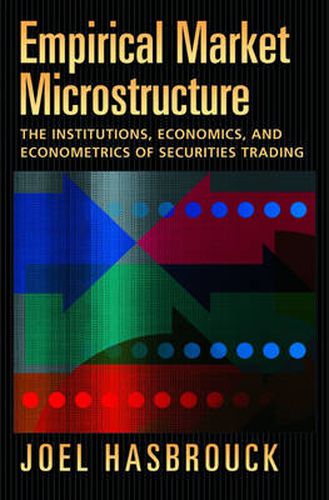Empirical Market Microstructure: The Institutions, Economics, and Econometrics of Securities Trading
Joel Hasbrouck (Professor of Finance, Stern School of Business, Professor of Finance, Stern School of Business, New York University)

Empirical Market Microstructure: The Institutions, Economics, and Econometrics of Securities Trading
Joel Hasbrouck (Professor of Finance, Stern School of Business, Professor of Finance, Stern School of Business, New York University)
The interactions that occur in securities markets are among the fastest, most information-intensive, and most highly strategic of all economic phenomena. Empirical Market Microstructure is about the institutions that have evolved to handle our trading needs, the economic forces that guide our strategies, and statistical methods of using and interpreting the vast amount of information that these markets produce. The empirical methods discussed in the book draw on the power of multivariate linear time series analysis. The book discusses the application of univariate ARMA analysis to trade prices, vector autoregressions to price and order data, and vector error correction models to situations where the same security is traded in many markets. In these models, the tools of random-walk decomposition and co-integration emerge as important to specification and interpretation.
The statistical specifications dont simply arise, however, as progressively more refined descriptive models; they have strong economic underpinnings arising from asymmetric information, inventory control, and the strategies of their participants. These topics are discusssed, interleaving with and emphasizing the connection to the statistical models.
From a practical viewpoint, many of these models will be estimated to calibrate real-world trading strategies. Some market participants will be trying to discern strategies that generate profits from short-term trading. A much greater number, though, will be trying to accomplish trades that help diversify, hedge or reallocate a portfolio. Trading is not, for these agents, their primary economic purpose. They are simply trying to satisfy their trading needs at a minimal cost. The final part of the book discusses how these costs are measured, and strategies to minimize them–both by splitting orders over time, and by the judicious use of limit orders.
The book includes numerous exercises; solutions and other supporting materials are available on the author’s web site.
This item is not currently in-stock. It can be ordered online and is expected to ship in approx 2 weeks
Our stock data is updated periodically, and availability may change throughout the day for in-demand items. Please call the relevant shop for the most current stock information. Prices are subject to change without notice.
Sign in or become a Readings Member to add this title to a wishlist.

